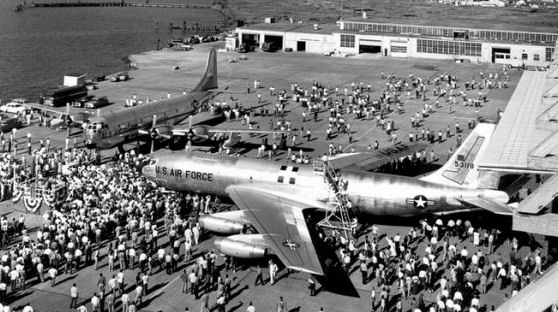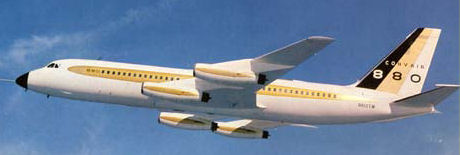|
|
|||
|
Privacy Policy | Editorial Policy | Profit Policy | Join the Association | List of Members | Contact us | Index | Links |
|||
|
Back Go to page: 1 2 3 4 5 6 7 8 9 10 11 12 13 14 15 16 17 18 19 20 Forward |
|||
|
|
|||
|
The Australian Defence Industry.
Most of us see or read the headlines about major defence
purchases, F-35 Joint Strike
The majority of ‘high value’ defence contracts go to Prime
contractors. This, in effect, means foreign owned multinational
companies. This is a fact of life, as there is little incentive
or
Australia, unlike most countries, does not have a broad based Industry Involvement plan, which mandates that Australian industry be included in any procurement of foreign manufactured military equipment. The only program that comes close is the Australian Industry Capability (AIC) plan, which mandates the inclusion of Australian industry in capital equipment purchases exceeding AUD20 million. This, of course, means that purchases under that threshold can originate from offshore companies with no Australian content. Even in the case of procurements above the $20mil threshold, the supplier can be relieved of Australian industry involvement, on a ‘Value for Money’ judgement by the bean counters! Such decisions can be made without any consideration of collateral effects such as tax revenue, jobs and in country capability development.
Many countries seek and achieve 100% direct offset against foreign purchases. One of the best examples is Canada, a country comparable in population and military assets to Australia. Canada has successfully achieved their offset goals over a period of thirty years or more. Principally, Canada procures directly from the OEM. This allows Canada to negotiate with the supplier and achieve the best deal on price and offset, whereas, with respect to most purchases from the US, Australia uses the Foreign Military Sales (FMS) avenue. In doing so Australia forfeits any opportunity to negotiate prices, terms and conditions.
Additionally, there is no competitive evaluation and no Australian industry involvement. FMS is, of course, easy, let the US take care of all the details and then pay whatever is asked.
Defence and government people will justify the use of FMS by claiming it is the most cost effective. This is not necessarily so as the US FMS agency applies a fee of a minimum 15% and there is no direct flow on to Australian industry.
Free Trade Agreements and Defence Treaties are often used to justify government to government purchases. The term ‘level playing field’ is frequently used. Once again, in the case of the US, there is a significant bias! Before goods, military or civil, can be purchased from a foreign country, there are many requirements that must be satisfied, Buy America Act, Small Business Set Aside, Service-Disabled Veterans, Women Owned Small Business etc, etc. All exempt from the Free trade Agreement, whereas Australian agencies, especially Defence, are not subjected to any such restrictions.
So, what can we do ? Tough question!! Over the past 20 years,
regardless of the political brand of government there has been no
initiative to offer preference to Australian companies.
As mentioned, the key players in the Australian defence industry, apart from multinationals, are the SMEs which are innovative, resourceful and responsive. However; in order to stay in business, retain, and develop capability, they need continuing income which can only come by giving preference and consideration to local businesses before going offshore.
Some 20 years ago a group of SMEs who had provided products to the ADF, saw their R & D and work ignored when Defence made an initial purchase from these companies and then went offshore for the follow on and future purchases. This group, with the assistance of what was the ISO, now ICN (Industry Capability Network) and the NSW Government, formed an organisation then known as the Australian Small Business Defence Network (ASBDN). This organisation soon became the Australian Industry & Defence Network (AIDN) a national body which is now represented in all States and Territories. Membership now comprises some 850 companies. The role of AIDN is to assist members in their dealings with Defence and to attempt to influence Defence and defence industry policy. Much has been achieved over the past 20 years. Achieving preferential treatment for Australian defence companies is still a primary goal, but continues to be elusive.
The key issue is to convince government that Australia’s future security and ability to build and maintain a largely self-sufficient defence industrial complex, must be recognised and supported by appropriate ‘whole of government’ action.
Having been on both sides of the equation, in uniform and in industry, I am passionate about Australia’s defence industry and future sovereign security. If you have waded through the foregoing and feel the same way, make sure to take the opportunity to make the situation and your feelings known to your local member and any other politicians you may come across.
Kev Carroll Executive Officer AIDN-Qld
|
|||
|
A few minutes before the church services started, the congregation was sitting in their pews and talking. Suddenly, Satan appeared at the front of the church. Everyone started screaming and running for the back entrance, trampling each other in a frantic effort to get away from evil incarnate. Soon the church was empty except for one elderly gentleman who sat calmly in his pew without moving, seemingly oblivious to the fact that God's ultimate enemy was in his presence. So Satan walked up to the man and said, "Do you know who I am?" The man replied, "Yep, sure do." "Aren't you afraid of me?" Satan asked. "Nope, sure ain't." said the man. "Don't you realise I can kill you with one word?" asked Satan. "Don't doubt it for a minute," returned the old man, in an even tone. "Did you know that I can cause you profound, horrifying AGONY for all eternity?" persisted Satan. "Yep," was the calm reply. "And you're still not afraid?" asked Satan. "Nope," said the old man. More than a little perturbed, Satan asked, "Why aren't you afraid of me?" The man calmly replied, "Been married to your sister for 48 years."
|
|||
|
The F-35.
When this thing eventually arrives at Willytown, half of Australia
will probably say
Brains immeasurably more powerful than ours have designed and then built this thing and they reckon it will do the job so we’re prepared to accept that it will. Seems it’s a fact of life these days that no matter what someone suggests or comes up with, there is always a bunch of people out there ever-ready to knock it and of course our compliant press always gives the knockers more exposure than they gave the originators.
Recently Aviation Week got on the band wagon with this story…..
”The F-35 Joint Strike Fighter (JSF)
program will certainly recover from the embarrassment
The stealthy, single-engine fighter has returned only to limited flying and the JSF program office and engine contractor Pratt & Whitney have yet to provide a detailed explanation of the June 23 fan-stage breakup that caused the grounding and what steps are being taken to assure it does not happen again.
Pratt cancelled a recent public briefing on the engine failure and there has been scant information since the middle of July on the source of the problem. The silence is disappointing but perhaps understandable, given that the accident investigation is still ongoing. But at some point, taxpayers are owed a full and open accounting of what went wrong and what steps are being taken to make sure such failures cannot happen again.
What is more, there are larger issues than technical details of the mishap itself. The most disturbing aspect of the grounding is that the F135 engine had completed engineering and manufacturing development (EMD) apparently without key issues being discovered. Unless it is truly a one-off, this sort of engine failure is normally the kind of fundamental design issue that engineers are expected to catch early in development and deal with long before flight tests even begin. That certainly raises questions about what else may have been missed during the EMD phase.
Not surprisingly, the failure of the Pratt engine has generated “I
told you so” talk of whether an international development effort of
this scope should have had an alternate engine as a backup.
GE and
Rolls-Royce were developing an advanced turbofan, dubbed the
F136, as
After the latest grounding, the Senate Appropriations Committee recommended to the Pentagon that it reconsider an alternate engine program but it is probably too late to unscramble the omelette. Pentagon acquisition chief Frank Kendall argues that the further downstream the program gets, the weaker the case for an alternate engine becomes. There is no free lunch; two engines cost more but a single source presents higher risk. However, program officials should at least consider whether there is a case for a mid-life alternative engine if it can draw on advances in commercial technology to keep the cost down.
For its part, Pratt should stop concealing the cost of the taxpayer-funded engine. What rings hollow is the company’s claim that the price of an engine on which it holds a monopoly is a competitive secret.
The JSF, for which Lockheed Martin is the airframe prime contractor, has not been riding waves of good news in recent years. Initial operating capability dates have finally been set for the three variants, beginning with the short-takeoff-and-vertical-landing F-35B by next December, followed by the F-35A for land-based air forces a year later and the F-35C for aircraft carriers in February 2019. But since the program began in 2001, the average unit cost has doubled and the date to begin full-rate production has slipped seven years to 2019. Most recently, in addition to the engine fire, problems include late software deliveries and serious questions about how much it will cost to maintain the fighter.
The F-35 program director, Air Force Lt. Gen. Christopher Bodgan, has been blunt in his displeasure about the performance of JSF contractors. The question now is whether the JSF can be kept from further schedule slips and cost overruns. The issues that caused this failure need to be identified and addressed. If they are, those lessons ultimately can drive better stewardship of other defense and space procurements”.
|
|||
|
|
|||
|
The Boeing 707. Robert Bogash
The 15th July, 1954, was a Day of Monumental Change. Aviation change, that is. World change. That is the Anniversary of an event that changed the course of commercial aviation, the world, and certainly of the Boeing Airplane Company.
That was the 60th Anniversary of the First Flight of the 707 Prototype, the Dash 80. The product of a bunch of engineers who probably lived in Bellevue, Washington, wore wing-tipped shoes with argyle socks, white shirts with pocket protectors and carried K & E slipsticks (slide rules.) They produced a machine that - on a dozen levels - changed the world.
But the first flight of this matriarch of Boeing's long line of descendant jet transports, as advanced as it was, might have led to a very different outcome. And, a very different Boeing. The story of the $16 million gamble to build the 707 with Boeing's own funds and no customers, has been told often. But, there was more to the story.
The success of Boeing's jet transport line was not the designing and building and flying of the 707, it was something else, a subtle but profound attitude change inside Boeing. And the critical event was not the kick-off order for the 707 from Pan Am, but rather the later order from American Airlines.
Although involved in designing and building commercial airliners for 25 years, Boeing had never really hit the jackpot when it came to putting their technical genius into widespread service with the airlines. Instead, they had proceeded, in fits and starts, with genuine technical marvels that seemed destined for great things, yet became somehow stuck in the starting blocks of their development cycle. Body Stretches, newer engines, more payload and range, these all seemed to not have happened.
In 1933, the 247 (right) was, following the Model 40 and 80, a mould-breaking leap into the future, truly the world's first modern airliner. And yet, only 75 were ever built. The design never really went anywhere. The competing Douglas DC2 sold almost 200, and, with a new body, morphed into the B-18 Bolo bomber. And, of course, the DC-2 became the DC-3, with a wider cabin, increasing capacity by 50% and with the addition of a cargo door morphed into the the legendary C-47 of which more than 10,000 built. It also got a new body becoming the B-23 Dragon bomber.
The 1934 the Lockheed Electra was quickly offered with shorter and
longer bodies and then
The Boeing 314 flying boat, the Clipper, again revolutionized
air travel, this time on long
When the B-29 sprouted a new body called the C-97, a civil version
was produced called
That COULD have been the future of the Dash 80 too. An instant replay of the KC-97 experience with a few commercial airplanes built for a few customers and the bulk becoming KC-135s for USAF. Once again, Boeing could have been first with the most, but last at the commercial dance. And, in fact, it almost DID play out that way.
There was divided opinion within Boeing as to whether the commercial
market, which had
After the 707 began flying, there was a lot of interest by the
airlines in the airplane, and
Still, the DC-8 (right) had several possible advantages, on paper
anyway, a bigger wing,
Not by much, but enough for the airlines to put in six-abreast seating. They wanted that. Boeing didn't. Boeing had already changed the body diameter once.
With the Dash 80, they had started out at the Stratocruiser cabin width, 132 inches, good for four abreast. They had designed it, built it, and test flown it. The drawings were released and the tooling was under construction. But then the Air Force, which became the first customer with an order for 29 airplanes, wanted it 12 inches wider, 144 inches, Boeing reluctantly agreed, and that was the 707 that Pan Am bought. Five abreast.
But the DC-8 was 147 inches. United wanted wider. Boeing was already re-doing all the engineering and tooling for the Air Force. Pan Am, Boeing's traditional kick-off customer, bought into 144 inches. Why not United? It was the Henry Ford moment for Boeing and Boeing said No. Any colour as long as it's black. Or 144 inches. United bought the DC-8.
After Tex Johnson rolled the Dash 80 over the hydro races, Eastern's President, Eddie Rickenbacker, had told the upset Boeing prez Bill Allen "He just sold your airplane for you." Maybe, but Capt. Eddie also bought the DC-8. Actually, so did Pan Am. After buying 20 707s with great fanfare in Seattle to kick off the jet age, Juan Trippe went down to L.A. the next day, shocking Boeing, and bought 25 DC-8s, making it clear that the DC-8 was the preferred future airplane for PAA - the 707 would be just a short term interim machine. For Trippe, it had only one advantage, timing. It allowed Pan Am to beat the rest of the world with jets. But, it didn't have the range. It was too small...................and it was too narrow.
|
|||
|
|
|||
|
Dual Rollout - the Last KC-97 and the First KC-135.
|
|||
|
Boeing had a big jump on the competition, time wise and technology wise, but it was starting to look like the 247, and the 307, and the 314, and the Stratocruiser all over again. The 707 appeared destined to be another KC-97 story, an Air Force tanker with a couple of commercial customers and a short, sweet production run. Douglas seemed destined to continue their dominance of the commercial airplane business.
That's when the real turning point came. Boeing's Ed Wells went to Tulsa, Oklahoma to try to sell the 707 to American, a long time Douglas customer that flew everything they ever made. American was 90% sold on the 707, they really liked the fact that Boeing had all this B-47 and B-52 multi-engine jet experience and that the Dash 80 was flying. They liked everything about the 707, except for one thing. They wanted it wider. 4.5 inches wider. They wanted it to be 148.5 inches wide, wider even than the DC-8.
This was gut check time. Everything that followed, all of Boeing's commercial business over the next half-century hung in the balance although the participants could not have known that. The dominance that would de-throne Douglas and make the word Boeing a generic dictionary term for jetliner.
Boeing had the right two guys involved, engineer Ed Wells (right) and company president Bill Allen. Maybe they sensed that everything was slip-sliding away anyway, Boeing blinked and became a whole new company. American got their 148.5 inches. They ordered 50 airplanes.
Having jumped into the pool, Boeing now went hog-wild in customer responsiveness. The DC-8 had a bigger wing and more range. Boeing designed a new bigger wing and called it the -320 Intercontinental. The 707 was too small so Boeing stretched it. The DC-8 had the more powerful JT-4 engines so Boeing installed the more powerful engines. Pan Am ordered 15. Seems the DC-8 might not be their airplane of the future -- after all.
Boeing now actually had TWO 707 airplanes, a smaller, shorter range one (-120) and a bigger, longer range one (-320.) The Henry Ford contingent inside Boeing had clearly lost their argument - Big Time - now it was ANY colour the customer wanted, and then some.
Things even started to get out of hand but the NEW Boeing agreed to anything an airline wanted. Braniff said we like the small airplane, but want the big engines from the big airplane. Boeing said "Sure". The -220 was born. Only five were ever built. The financials must have been mind-boggling. QANTAS said, we like the small airplane, but it's TOO big - make it shorter. Boeing said "Sure", and the -138 was born. Only 13 of those were ever built. BOAC said we like the -320, but we don't want those "Yank" engines from Pratt & Whitney. We want good old Rolls-Royce engines.
Boeing said "Sure", and the -420 was born.
Eventually, a lighter shorter range airplane seemed needed, maybe to cut Convair off at the Pass with their new, smaller 880 (right). So the 720 series was born. And United and Eastern bought it. So did DC-8 operator Northwest, who eventually converted into an all 707/720 fleet.
New Fan engines came out, and were installed. Myriad revisions were made to leading and trailing edge flaps, the vertical fin, assorted ventral fins, horizontal stabilizers, cargo doors and floors, for convertibles, freighters. Boeing was reborn. In two years, Douglas had lost the lead, for good in the airliner business, never to regain it. Boeing responded to nearly every customer request and niche. The accountants might have not liked it, but the airlines sure did.
Within just a couple of years, the 727 trijet came along, essentially uncontested in the marketplace, and then the 737, and the jumbo 747. In the 10 years from 1956 to 1966, Boeing had remade itself, and the commercial airplane world, and Planet Earth. A new King had been born and although the first flight of the 707 Prototype - the Dash 80 - 60 years ago could be viewed as the seminal event, in fact this technical triumph had to be matched by a paradigm shift in customer responsiveness.
And, it all came down to Ed Wells, and Bill Allen, ...... and 4.5 inches.
|
|||
|
Two well-dressed ladies happened to start up a conversation during an endless wait in the Brisbane Airport Terminal. The first lady was an arrogant Victorian married to a wealthy business man. The second was a well-mannered elderly woman from Mount Isa, Queensland. After a little while Victorian woman started by saying, "When my first child was born, my husband built a beautiful mansion for me." The lady from Mount Isa commented, "Well, isn't that precious?" The first woman continued, "When my second child was born, my husband bought me a beautiful Mercedes-Benz." Again, the lady from Mount Isa commented, "Well, isn't that precious?" The first woman went on, "Then, when my third child was born, my husband bought me this exquisite diamond bracelet." Yet again, the Mount Isa lady commented, "Well, isn't that precious?"
The first woman then asked , "What did your husband buy for you when you had your first child?" “My husband sent me to charm school," declared the Mount Isa lady. "Charm school?" the first woman cried, "Oh, my Lord! What could they teach you??"
The Mount Isa lady responded, "Well as an example... instead of saying, "Who gives a stuff?", I learned to say, "Well, isn't that precious?".
|
|||
|
|
|||
|
|
|||
|
|
|||
|
|
|||
|
Back Go to page: 1 2 3 4 5 6 7 8 9 10 11 12 13 14 15 16 17 18 19 20 Forward |

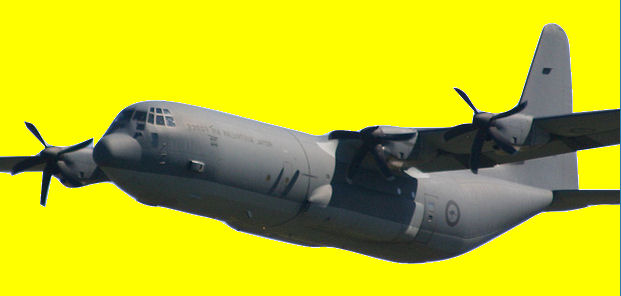
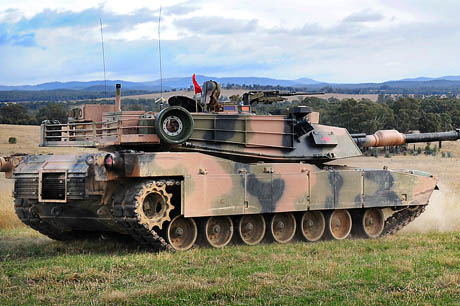 capital
available to support indigenous Defence companies hence, the
truly Australian defence companies fall into the SME category.
However; because of the desire and need to equip our forces with
the latest and best equipment, the multinationals are essential,
given that most of them are the OEMs (Original Equipment
Manufacturers).
capital
available to support indigenous Defence companies hence, the
truly Australian defence companies fall into the SME category.
However; because of the desire and need to equip our forces with
the latest and best equipment, the multinationals are essential,
given that most of them are the OEMs (Original Equipment
Manufacturers). “I told you so” or if not, the other half will say “I told you so” for the
exact opposite reason. At the moment, of those that care one way or the other, half
say it is the best thing since sliced bread, the other that it is
like an ash tray on a motor bike – but who is right?? - only time
will tell. There has been so much written about it by arm-chair
experts that we don’t know what to expect – our suggestion, take
heed in the old saying, “horses for courses!!!’
“I told you so” or if not, the other half will say “I told you so” for the
exact opposite reason. At the moment, of those that care one way or the other, half
say it is the best thing since sliced bread, the other that it is
like an ash tray on a motor bike – but who is right?? - only time
will tell. There has been so much written about it by arm-chair
experts that we don’t know what to expect – our suggestion, take
heed in the old saying, “horses for courses!!!’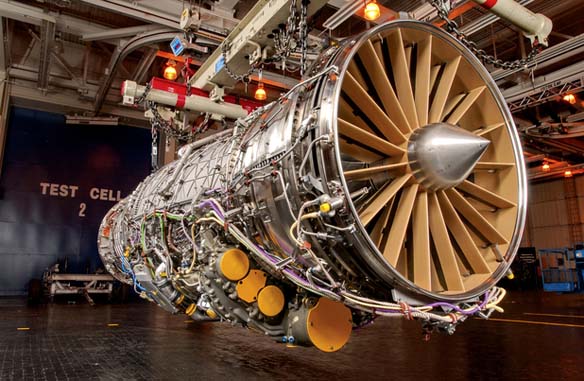 an alternative for powering JSF but the
an alternative for powering JSF but the 
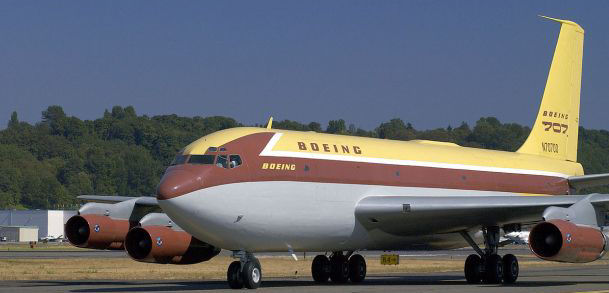
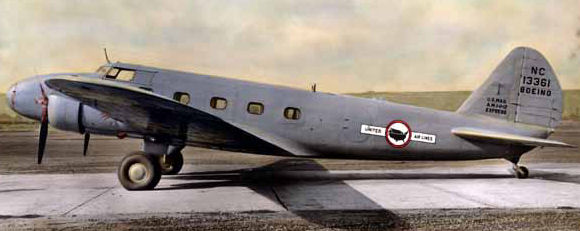
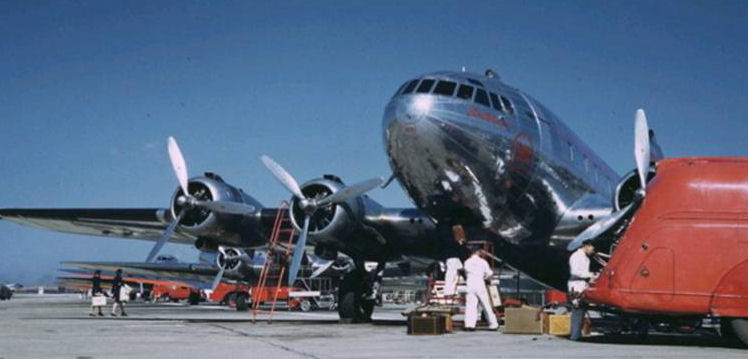 yet bigger fuselages and wings as the Hudson and Ventura patrol
bombers, ultimately selling almost 7000 airplanes. Boeing continued
to lead the way (technically) with the 307 Stratoliner, the
world's first production pressurized airliner but only ten were ever
built and only nine entered service. The somewhat competing
unpressurized DC-4, became the military C-54, then the DC-6 and DC-7
series, selling thousands of airframes.
yet bigger fuselages and wings as the Hudson and Ventura patrol
bombers, ultimately selling almost 7000 airplanes. Boeing continued
to lead the way (technically) with the 307 Stratoliner, the
world's first production pressurized airliner but only ten were ever
built and only nine entered service. The somewhat competing
unpressurized DC-4, became the military C-54, then the DC-6 and DC-7
series, selling thousands of airframes. range over-ocean routes but only 12 were ever built, all for
essentially one customer - Pan Am. Despite the production of
thousands of flying boats for WW II, many large like the Clipper,
the 314 never saw a bomber or reconnaissance or follow-on transport
development.
range over-ocean routes but only 12 were ever built, all for
essentially one customer - Pan Am. Despite the production of
thousands of flying boats for WW II, many large like the Clipper,
the 314 never saw a bomber or reconnaissance or follow-on transport
development.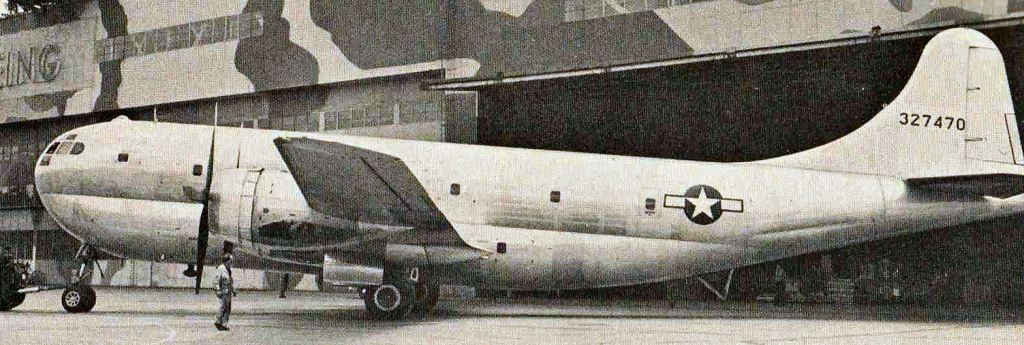 the Stratocruiser. Douglas's evolving line of DC-6s and Lockheed's
Constellations, kept getting bigger and longer and faster while the
Stratocruiser languished with just a few customers and little change
from its roll-out configuration. Its future lay with the Air Force,
as only 56 Strats were ever built for a few airlines while over 800
were built for USAF.
the Stratocruiser. Douglas's evolving line of DC-6s and Lockheed's
Constellations, kept getting bigger and longer and faster while the
Stratocruiser languished with just a few customers and little change
from its roll-out configuration. Its future lay with the Air Force,
as only 56 Strats were ever built for a few airlines while over 800
were built for USAF.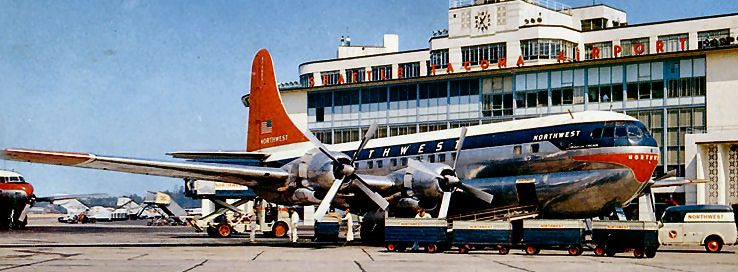 eluded the company for so long, was even worth pursuing. Many
thought selling to the government was just fine. Others, looking at
the success of Lockheed and Douglas, felt the company needed the
balance of a dual customer base. The decision ultimately came down
to just a few inches. Would we, or wouldn't we? Was it to be Henry
Ford's way, or the highway?
eluded the company for so long, was even worth pursuing. Many
thought selling to the government was just fine. Others, looking at
the success of Lockheed and Douglas, felt the company needed the
balance of a dual customer base. The decision ultimately came down
to just a few inches. Would we, or wouldn't we? Was it to be Henry
Ford's way, or the highway?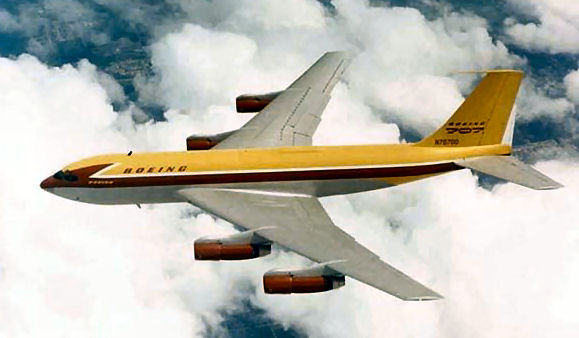 certainly interest by the competition. A couple of twists of fate,
like football blockers, had served to allow Boeing to slip through
the line and gain a jump of several years on the other guys.
Lockheed had won the transport competition that ultimately resulted
in the C-130 Hercules. That tied up their resources during the Dash
80 design and build window. And, ironically, C.R. Smith, President
of American Airlines, had twisted Donald Douglas's arm long enough,
and hard enough, until Douglas agreed to build a follow-on to the
popular DC-6 series, that became the DC-7. With their engineers all
tied up, Douglas had to play catch-up football after the 707 rolled
out and began flying. Their entrant was the DC-8 and it was badly
behind the 707.
certainly interest by the competition. A couple of twists of fate,
like football blockers, had served to allow Boeing to slip through
the line and gain a jump of several years on the other guys.
Lockheed had won the transport competition that ultimately resulted
in the C-130 Hercules. That tied up their resources during the Dash
80 design and build window. And, ironically, C.R. Smith, President
of American Airlines, had twisted Donald Douglas's arm long enough,
and hard enough, until Douglas agreed to build a follow-on to the
popular DC-6 series, that became the DC-7. With their engineers all
tied up, Douglas had to play catch-up football after the 707 rolled
out and began flying. Their entrant was the DC-8 and it was badly
behind the 707. more powerful engines and greater range. It also had the unshakable
confidence of most of the world's airlines, which had decades of
experience with Douglas and their airplanes and knew the Douglas's,
Senior and Junior intimately. And it also had one other advantage -
which turned out to be a big one - it was wider.
more powerful engines and greater range. It also had the unshakable
confidence of most of the world's airlines, which had decades of
experience with Douglas and their airplanes and knew the Douglas's,
Senior and Junior intimately. And it also had one other advantage -
which turned out to be a big one - it was wider.